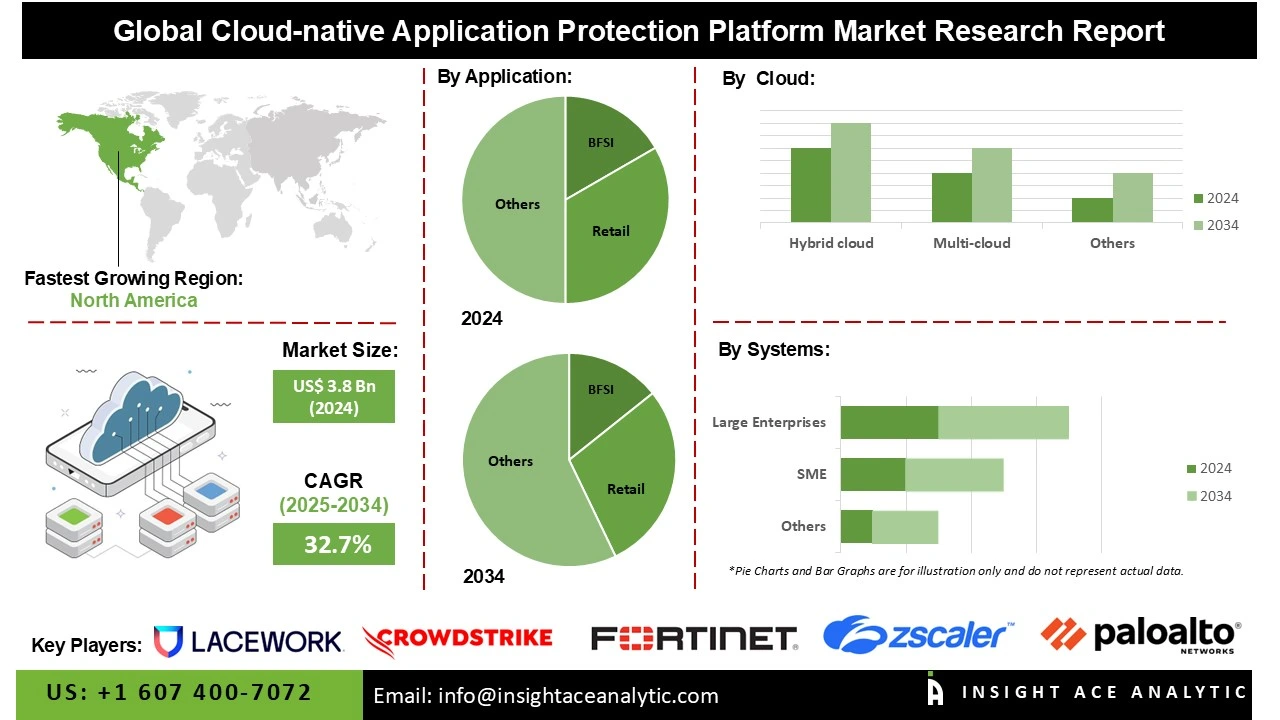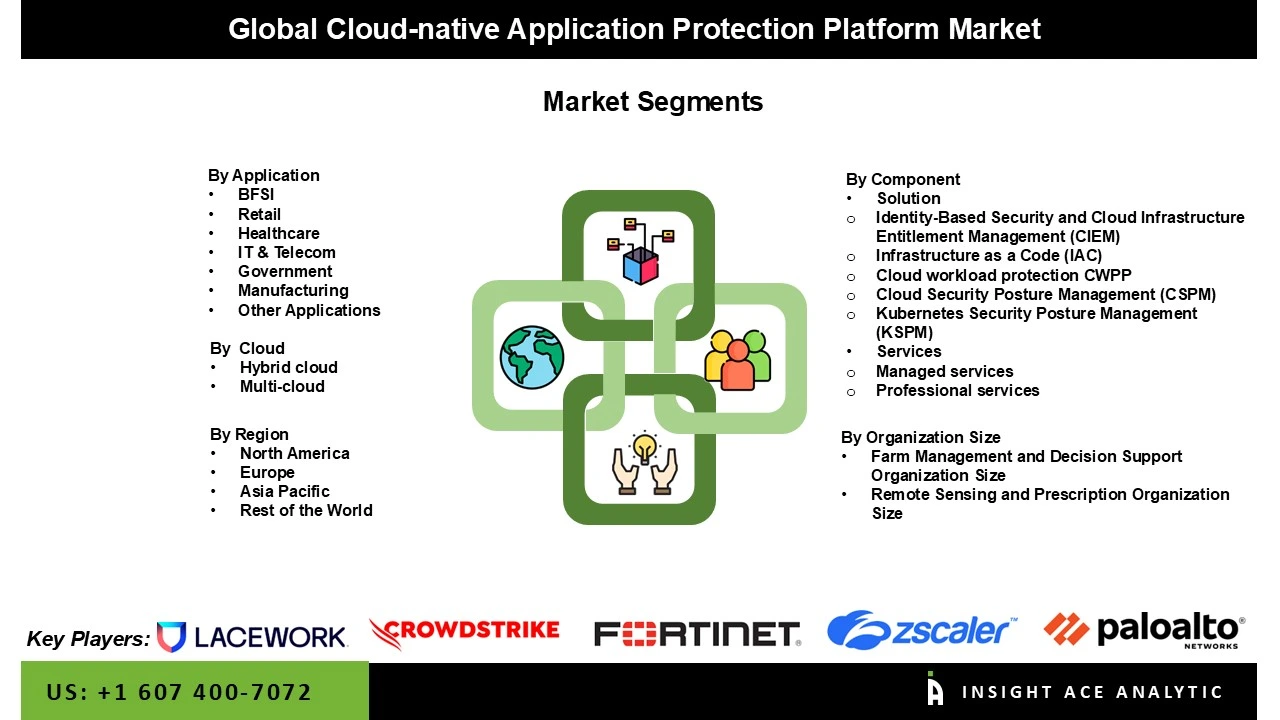Cloud-Native Application Protection Platform Market Size is valued at US$ 3.8 Bn in 2024 and is predicted to reach US$ 61.6 Bn by the year 2034 at an 32.7% CAGR during the forecast period for 2025-2034.

Cloud-native application protection platforms (CNAPPs) offer comprehensive security for cloud-native environments, encompassing compliance management, workload protection, and runtime protection. These systems are designed to protect apps developed with cloud-native technologies, ensuring they are safe from a variety of online threats.
The shift to microservices and containerization, which has made application security more challenging and rendered conventional security methods inadequate, is a major factor driving the market for cloud-native application protection platforms over the forecast period.
Furthermore, the enormous need for cloud-native application protection platforms across various industries, including e-commerce, telecommunications, BFSI, IT & ITES, and healthcare, is driving the growth of the global cloud-native application protection platform (CNAPP) market throughout the forecast period.
Additionally, the cloud-native application protection platform (CNAPP) industry has expanded globally due to the increased acceptance of the BYOD idea and cloud-based technologies. However, the lack of qualified workers may hinder the expansion of the global market for cloud-native application protection platforms (CNAPPs). Nonetheless, the widespread adoption of cloud-native application protection platforms (CNAPPs) across various industries will create new opportunities for the global industry to expand.
Some of the Key Players in Cloud-Native Application Protection Platform Market:
· LaceWorks
· Palo Alto Networks
· Checkpoint Security
· Fortinet
· Zscaler
· CrowdStrike
· Tenable
· Orca Security
· Microsoft (Microsoft Defender for Cloud)
· Qualys
· Wiz
· Trend Micro
· Others
The cloud-native application protection platform market is segmented by component, organization size, cloud, and application. By component, the market is segmented into solution [cloud workload protection (CWPP), identity-based security and cloud infrastructure entitlement management (CIEM), cloud security posture management (CSPM), infrastructure as a code (IAC), kubernetes security posture management (KSPM)] and services [professional services, managed services].
By organization size, the market is segmented into SME and large enterprises. By cloud, the market is segmented into hybrid cloud and multi-cloud. By Application, the market is segmented into BFSI, healthcare, IT & telecom, manufacturing, retail, government, and others.
The solutions segment held the greatest market share in 2024. Through the integration of global threat databases and the utilisation of collective intelligence from multiple sources, cloud-native application protection platforms (CNAPPs) are enhancing their threat intelligence capabilities. To foresee possible attack pathways, comprehend new dangers, and implement defence plans, these platforms are developing sophisticated predictive security models. Context-aware security solutions that correlate threat data across domains are the major focus, leading to more sophisticated and astute risk assessments.
The cloud-native application protection platforms market's largest category is hybrid cloud, as companies progressively shift to on-premises and multi-cloud systems to strike a balance between scalability, control, and compliance. Security silos are reduced in hybrid environments by CNAPP, which provides visibility, threat detection, and policy enforcement across all types of infrastructure within enterprises.
One example of a hybrid cloud application is Microsoft Defender for Cloud, which provides end-to-end security control across Azure, AWS, and on-premises workloads. The dominance of the category demonstrates the confidence organisations have in hybrid cloud security when shielded by comprehensive CNAPP solutions that offer automated response capabilities, real-time threat detection, and ongoing compliance monitoring.
In 2024, North America region held the largest share in the cloud-native application protection platforms market. In terms of infrastructure and security technology use, it is among the most developed regions.
Cloud technology usage and digitization have increased significantly in the region. The amount of money spent by IT on system infrastructure is gradually moving from conventional to cloud-based solutions. Organisations are rapidly adopting cloud services to replace outdated systems or launch new projects. The market expansion in North America is fueled in part by the regional presence of major industry players providing CNAPP. The region's CNAPP market is expanding due to the increasing number of cyberattacks occurring there.
During the projection period, the market for cloud-native application protection platforms in Europe is expected to expand at a substantial rate. Stringent data protection laws and a strong emphasis on privacy drive the demand for cloud-native application protection platforms in the European Union.
The introduction of the GDPR has been a significant motivator for businesses to adopt thorough security protocols for cloud applications. High regulatory compliance standards, an established cloud adoption landscape, and a proactive cybersecurity strategy are essential components. Furthermore, the region's need for CNAPP is being fueled by the growing adoption of cloud services in critical industries such as banking, healthcare, and government, as well as the expansion of remote working and digital transformation initiatives.
Cloud-Native Application Protection Platform Market by Component-
· Solution
o Cloud workload protection (CWPP)
o Identity-Based Security and Cloud Infrastructure Entitlement Management (CIEM)
o Cloud Security Posture Management (CSPM)
o Infrastructure as a Code (IAC)
o Kubernetes Security Posture Management (KSPM)
· Services
o Professional services
o Managed services

Cloud-Native Application Protection Platform Market by Organization Size -
· SME
· Large Enterprises
Cloud-Native Application Protection Platform Market by Cloud-
· Hybrid cloud
· Multi-cloud
Cloud-Native Application Protection Platform Market by Application-
· BFSI
· Healthcare
· IT & Telecom
· Manufacturing
· Retail
· Government
· Others
Cloud-Native Application Protection Platform Market by Region-
North America-
· The US
· Canada
Europe-
· Germany
· The UK
· France
· Italy
· Spain
· Rest of Europe
Asia-Pacific-
· China
· Japan
· India
· South Korea
· Southeast Asia
· Rest of Asia Pacific
Latin America-
· Brazil
· Argentina
· Mexico
· Rest of Latin America
Middle East & Africa-
· GCC Countries
· South Africa
· Rest of the Middle East and Africa
Chapter 1. Methodology and Scope
1.1. Research Methodology
1.2. Research Scope & Assumptions
Chapter 2. Executive Summary
Chapter 3. Global Cloud-native Application Protection Platform Market Snapshot
Chapter 4. Global Cloud-native Application Protection Platform Market Variables, Trends & Scope
4.1. Market Segmentation & Scope
4.2. Drivers
4.3. Challenges
4.4. Trends
4.5. Investment and Funding Analysis
4.6. Porter's Five Forces Analysis
4.7. Incremental Opportunity Analysis (US$ MN), 2025-2034
4.8. Global Cloud-native Application Protection Platform Market Penetration & Growth Prospect Mapping (US$ Mn), 2025-2034
4.9. Competitive Landscape & Market Share Analysis, By Key Player (2025)
4.10. Use/impact of AI on CLOUD-NATIVE APPLICATION PROTECTION PLATFORM MARKET Industry Trends
Chapter 5. Cloud-native Application Protection Platform Market Segmentation 1: By Component, Estimates & Trend Analysis
5.1. Market Share by Component, 2025 & 2034
5.2. Market Size (Value US$ Mn) & Forecasts and Trend Analyses, 2021 to 2034 for the following Component:
5.2.1. Solution
5.2.1.1. Identity-Based Security and Cloud Infrastructure Entitlement Management (CIEM)
5.2.1.2. Infrastructure as a Code (IAC)
5.2.1.3. Cloud workload protection CWPP
5.2.1.4. Cloud Security Posture Management (CSPM)
5.2.1.5. Kubernetes Security Posture Management (KSPM)
5.2.2. Services
5.2.2.1. Managed services
5.2.2.2. Professional services
Chapter 6. Cloud-native Application Protection Platform Market Segmentation 2: By Cloud, Estimates & Trend Analysis
6.1. Market Share by Cloud, 2025 & 2034
6.2. Market Size (Value US$ Mn) & Forecasts and Trend Analyses, 2021 to 2034 for the following Cloud:
6.2.1. Hybrid cloud
6.2.2. Multi-cloud
Chapter 7. Cloud-native Application Protection Platform Market Segmentation 3: By Organization Size, Estimates & Trend Analysis
7.1. Market Share by Organization Size, 2025 & 2034
7.2. Market Size (Value US$ Mn) & Forecasts and Trend Analyses, 2021 to 2034 for the following Organization Size:
7.2.1. SME
7.2.2. Large Enterprises
Chapter 8. Cloud-native Application Protection Platform Market Segmentation 4: By Application, Estimates & Trend Analysis
8.1. Market Share by Application, 2025 & 2034
8.2. Market Size (Value US$ Mn) & Forecasts and Trend Analyses, 2021 to 2034 for the following Application:
8.2.1. BFSI
8.2.2. Retail
8.2.3. Healthcare
8.2.4. IT & Telecom
8.2.5. Government
8.2.6. Manufacturing
8.2.7. Other Applications
Chapter 9. Cloud-native Application Protection Platform Market Segmentation 5: Regional Estimates & Trend Analysis
9.1. Global Cloud-native Application Protection Platform Market, Regional Snapshot 2023 & 2034
9.2. North America
9.2.1. North America Cloud-native Application Protection Platform Market Revenue (US$ Million) Estimates and Forecasts by Country, 2021-2034
9.2.1.1. US
9.2.1.2. Canada
9.2.2. North America Cloud-native Application Protection Platform Market Revenue (US$ Million) Estimates and Forecasts by Component, 2021-2034
9.2.3. North America Cloud-native Application Protection Platform Market Revenue (US$ Million) Estimates and Forecasts by Cloud, 2021-2034
9.2.4. North America Cloud-native Application Protection Platform Market Revenue (US$ Million) Estimates and Forecasts by Organization Size, 2021-2034
9.2.5. North America Cloud-native Application Protection Platform Market Revenue (US$ Million) Estimates and Forecasts by Application, 2021-2034
9.3. Europe
9.3.1. Europe Cloud-native Application Protection Platform Market Revenue (US$ Million) Estimates and Forecasts by Country, 2021-2034
9.3.1.1. Germany
9.3.1.2. U.K.
9.3.1.3. France
9.3.1.4. Italy
9.3.1.5. Spain
9.3.1.6. Rest of Europe
9.3.2. Europe Cloud-native Application Protection Platform Market Revenue (US$ Million) Estimates and Forecasts by Component, 2021-2034
9.3.3. Europe Cloud-native Application Protection Platform Market Revenue (US$ Million) Estimates and Forecasts by Cloud, 2021-2034
9.3.4. Europe Cloud-native Application Protection Platform Market Revenue (US$ Million) Estimates and Forecasts by Organization Size, 2021-2034
9.3.5. Europe Cloud-native Application Protection Platform Market Revenue (US$ Million) Estimates and Forecasts by Application, 2021-2034
9.4. Asia Pacific
9.4.1. Asia Pacific Cloud-native Application Protection Platform Market Revenue (US$ Million) Estimates and Forecasts by Country, 2021-2034
9.4.1.1. India
9.4.1.2. China
9.4.1.3. Japan
9.4.1.4. Australia
9.4.1.5. South Korea
9.4.1.6. Hong Kong
9.4.1.7. Southeast Asia
9.4.1.8. Rest of Asia Pacific
9.4.2. Asia Pacific Cloud-native Application Protection Platform Market Revenue (US$ Million) Estimates and Forecasts by Component, 2021-2034
9.4.3. Asia Pacific Cloud-native Application Protection Platform Market Revenue (US$ Million) Estimates and Forecasts by Cloud, 2021-2034
9.4.4. Asia Pacific Cloud-native Application Protection Platform Market Revenue (US$ Million) Estimates and Forecasts by Organization Size, 2021-2034
9.4.5. Asia Pacific Cloud-native Application Protection Platform Market Revenue (US$ Million) Estimates and Forecasts by Application, 2021-2034
9.5. Latin America
9.5.1. Latin America Cloud-native Application Protection Platform Market Revenue (US$ Million) Estimates and Forecasts by Country, 2021-2034
9.5.1.1. Brazil
9.5.1.2. Mexico
9.5.1.3. Rest of Latin America
9.5.2. Latin America Cloud-native Application Protection Platform Market Revenue (US$ Million) Estimates and Forecasts by Component, 2021-2034
9.5.3. Latin America Cloud-native Application Protection Platform Market Revenue (US$ Million) Estimates and Forecasts by Cloud, 2021-2034
9.5.4. Latin America Cloud-native Application Protection Platform Market Revenue (US$ Million) Estimates and Forecasts by Organization Size, 2021-2034
9.5.5. Latin America Cloud-native Application Protection Platform Market Revenue (US$ Million) Estimates and Forecasts by Application, 2021-2034
9.6. Middle East & Africa
9.6.1. Middle East & Africa Cloud-native Application Protection Platform Market Revenue (US$ Million) Estimates and Forecasts by country, 2021-2034
9.6.1.1. GCC Countries
9.6.1.2. Israel
9.6.1.3. South Africa
9.6.1.4. Rest of Middle East and Africa
9.6.2. Middle East & Africa Cloud-native Application Protection Platform Market Revenue (US$ Million) Estimates and Forecasts by Component, 2021-2034
9.6.3. Middle East & Africa Cloud-native Application Protection Platform Market Revenue (US$ Million) Estimates and Forecasts by Cloud, 2021-2034
9.6.4. Middle East & Africa Cloud-native Application Protection Platform Market Revenue (US$ Million) Estimates and Forecasts by Organization Size, 2021-2034
9.6.5. Middle East & Africa Cloud-native Application Protection Platform Market Revenue (US$ Million) Estimates and Forecasts by Application, 2021-2034
Chapter 10. Competitive Landscape
10.1. Major Mergers and Acquisitions/Strategic Alliances
10.2. Company Profiles
10.2.1. Checkpoint Security
10.2.1.1. Business Overview
10.2.1.2. Key Product/Service
10.2.1.3. Financial Performance
10.2.1.4. Geographical Presence
10.2.1.5. Recent Developments with Business Strategy
10.2.2. CrowdStrike
10.2.3. LaceWorks
10.2.4. Fortinet
10.2.5. Zscaler
10.2.6. Palo Alto Networks
10.2.7. Tenable
10.2.8. Qualys
10.2.9. Wiz
10.2.10. Trend Micro
10.2.11. Orca Security
10.2.12. Microsoft (Microsoft Defender for Cloud)
10.2.13. Other Key Players